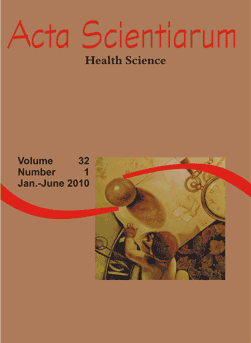<b>Epidemiological data of salmonellosis outbreaks occured between 1999 and 2008 in Parana State, Brazil</b> - DOI: 10.4025/actascihealthsci.v32i1.6340
Keywords:
foodborne disease, salmonellosis, Salmonella Enteritidis
Abstract
Epidemiological data of foodborne diseases in Brazil are scarce. In Paraná State, there is little information on the prevalence of Salmonella serovars and fagotypes involved in outbreaks. The aim of this study was to evaluate epidemiological data of salmonellosis outbreaks notified in Paraná State between January 1999 and December 2008. During the study period, 286 Salmonella outbreaks occurred and a total of 5,641 people were exposed, 2,027 (35.9%) became ill, and 881 (16.3%) were hospitalized. Fifty-two cities (13.0%) in Paraná notified Salmonella outbreaks. Eggs and egg products, meat and meat products and other foods were, respectively, associated with 45.0, 34.8 and 20.2% of the notified outbreaks. Serovar Enteritidis was prevalent and identified in 87.8% of the strains isolated from patients and in 80.6% of the strains isolated from food involved in outbreaks. Salmonella Enteritidis PT4 was the prevalent phagotype. However, a prevalence of PT9 occurred after 2003. Of the total number of outbreaks analyzed, 49.7% occurred in residences. This result indicates that educational actions of the State Food Safety and Inspection Service should be for both commercial and domestic food handlers.Downloads
Download data is not yet available.
Published
2009-12-07
How to Cite
Kottwitz, L. B. M., Oliveira, T. C. R. M. de, Alcocer, I., Farah, S., Abrahão, W. M., & Rodrigues, D. dos P. (2009). <b>Epidemiological data of salmonellosis outbreaks occured between 1999 and 2008 in Parana State, Brazil</b> - DOI: 10.4025/actascihealthsci.v32i1.6340. Acta Scientiarum. Health Sciences, 32(1), 9-15. https://doi.org/10.4025/actascihealthsci.v32i1.6340
Issue
Section
Health Sciences
DECLARATION OF ORIGINALITY AND COPYRIGHTS
I Declare that current article is original and has not been submitted for publication, in part or in whole, to any other national or international journal.
The copyrights belong exclusively to the authors. Published content is licensed under Creative Commons Attribution 4.0 (CC BY 4.0) guidelines, which allows sharing (copy and distribution of the material in any medium or format) and adaptation (remix, transform, and build upon the material) for any purpose, even commercially, under the terms of attribution.
Read this link for further information on how to use CC BY 4.0 properly.























5.png)







